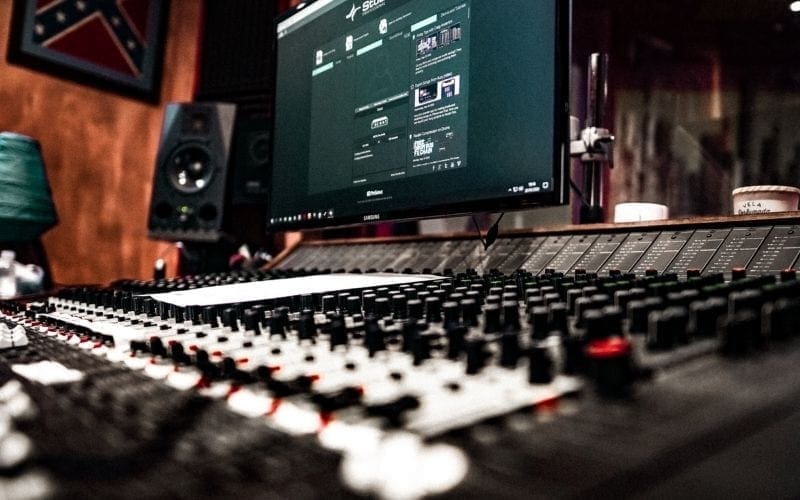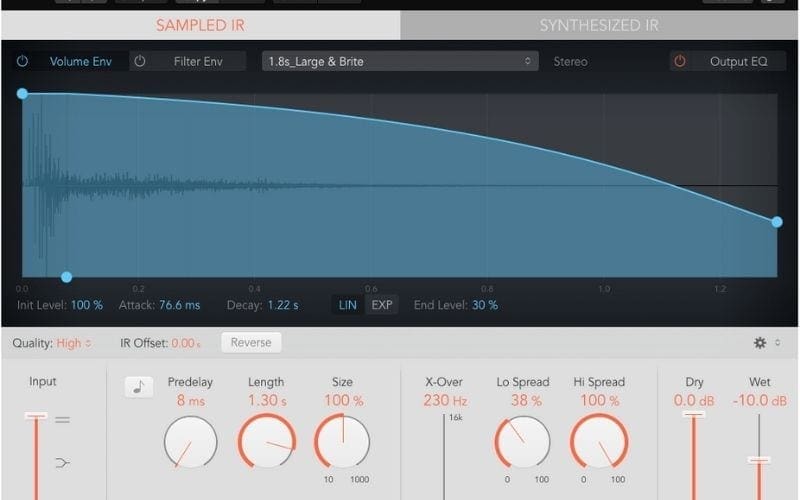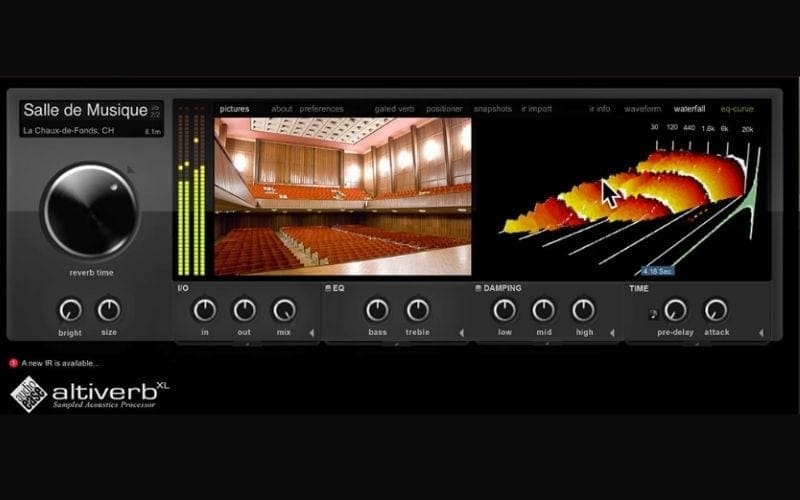It’s really important to understand the music you’re making and how you want it to sound. This helps if you want to add it in yourself to add depth when mixing and mastering your music. Or if there’s any unwanted reverb. Understanding reverb can also help you decide which type of space you’d like to record your music in. Firstly, we’ll evaluate and break down how sound is shaped and changed by a real room or space. Secondly, we’ll discuss how reverb plugins and outboard gear emulate real rooms or halls, a technique known as convolution reverb. Thirdly, we’ll cover how plugins, hardware, and even springs and metal plates can create artificial spaces and sounds to enhance and add a creative spin to a sound. Hopefully, after reading this article you’ll feel well-versed in the different types of reverb, both natural and artificial!
What Is Reverb?

Reverb is the persistence of sound after a sound is produced. Reverb is created when a sound or signal is reflected off of a surface causing numerous reflections to build up. They then decay as the sound and reflections are absorbed by the surfaces of the objects around it. The original sound source can stop but the reflections continue, decreasing in amplitude (volume) until they reach zero. Reverb defines how a sound sits in a space. In all aspects of our daily lives, we experience the effects that reverb has on the sounds that we hear.
Here’s some example of amazing reverb tracks:
Led Zeppelin – ‘When The Levee Breaks’
This legendary track was famously recorded in a 3 story staircase. The fact that 2 microphones were placed at the top of the staircase gives it its ‘big’ sound making the instruments seem like they’re swirling.
Phil Collins – ‘In The Air Tonight’
Perhaps the most famous track that uses grated reverb with the help of a noise gate. The use of reverb gives the epic drum solo immense power while keeping the vocals smooth and tight.
How Does Reverb Work?

We hear sound in two different ways. First, the direct sound, straight from the source. Second, the sound is reflected and manipulated by the room.
As sound leaves its source, it travels in a fashion similar to light. Sound leaves the object in a spherical way, bouncing and bumping into everything in every direction – some materials reflect it, while others modify the sound as it passes through the material. These three types of interactions are instrumental to the reverb time of a space, and thereby our perception of the sounds that occur in those spaces.
The ramifications are huge when we consider how millennia-old techniques, combined with modern capabilities, can be applied to audio production and engineering. With correct management of reverb plug-ins or hardware and careful consideration of reverb’s effects when recording we can make any sound seem like it was recorded anywhere.
Understanding Reverb Better
Reverberated sound is sound that reflects off of an object before it reaches our ears and is altered by the object that it hits. Have you ever noticed the hush on a snowy day, or how the walls sing back to you in a tunnel? Snow absorbs sound, meaning less of it bounces around off of the hard surfaces such as road and pavement, so we hear less sound than if there was no snow.
Inversely, in a tunnel, we are surrounded by reflective surfaces that can bounce sound back to us, sound tends to hang around a lot longer, and has a longer reverb time.
Architects, acoustic engineers, and designers have used this understanding to create some of the most famous buildings, concert halls, stadiums, colosseums, and public spaces. We, as creators, performers, and audiences, knew thousands of years ago, that for a story to resonate properly it has to sound right. Both puns intended.
Reverb In Real Rooms and Spaces
Before an engineer can even think about what types of reverb to apply to a sound, they must first consider the sound of the recording that they have. The size, layout, and construction materials of a room or space all have a direct impact on the sound of recordings, not to mention mic placement, polar patterns, the location in the space, and a plethora of other variables.
What we’re talking about is acoustics, one of the more scientific branches of music and music production, as it is a branch of physics foremost. Acoustics is our way of analyzing and measuring sound and the way it behaves in an environment. We can use knowledge of acoustics to calculate the way a space will reverberate in relation to a sound source. Dependent on materials, shape, size, space, layout, furniture, and so many other factors, reverb is everywhere and affected by everything.
RT60 Specification
The RT60 Specification is to provide an objective measure of reverb time. The calculation is a measure of how long it takes a sound to decay by 60 dB(decibels) in a room large enough that reflections from the source reach the mic from all directions at the same level. Using RT60 calculations we can figure out the time of certain frequencies in a space, and we can thereby use these calculations to attenuate for unwanted, resonating sounds in recordings.
Recording studios sound the way that they do by utilizing these principles; from the beautifully reflective live rooms to the almost-too-intimate vocal booths. These spaces are built with acoustic principles in mind. Vocal booths, in particular, are designed to create a ‘dead space’ where the sound isn’t reflected or altered by the room, meaning that the microphone only picks up direct sound and no reverb from the room. These spaces allow engineers to make a recording sound like it was recorded anywhere.

Reverb Chambers
Reverb chambers are real “rooms” constructed for the sole purpose of creating a space to be recorded and used in recordings. There are a few iconic echo chambers in the world with two of the most well known being the echo chambers at Abbey Road Studios and Capitol Studios under the Capitol Records building in Hollywood, CA. There are eight concrete echo chambers 30 feet underneath the Capitol Records building. The way an echo chamber is used is much like a Send/Return channel in a DAW. An audio signal is sent to the chamber with the audio being played through a speaker. A mic in the chamber records the reverb and it is sent back to the console where it is blended in with the original sound.
Convolution Reverb
One of the most common ways to make recordings seem like they were recorded in different locations is convolution reverb.
Convolution is the process of measuring the sonic character of a real space. A sound such as white noise or a starter pistol is triggered. The trigger sound is known as the impulse. After the impulse is triggered the impulse signal and the resulting room reverb is recorded. The impulse and room response is fed into a convolution processor that produces an “impulse response.” This is the general signature of the room. Convolution reverb units apply this impulse response to a new signal creating a very realistic emulation of the sound in the original measured space.
When applying a convolution reverb, one of the most important rules is consistency. Generally speaking, an engineer wouldn’t apply convolution reverbs based on 5 different spaces to 5 different tracks in the same song. It would likely sound uncomfortable, and the sounds would get in the way of each other. An engineer can easily apply the same sound to multiple tracks by placing the reverb on a bus channel. This makes them sound like they are recorded together. In using this technique, the engineer also has control over how much reverb is applied.
Reverb Plugins and Hardware
The evolution of mechanical reverb has gone from constructed reverb chambers to hardware and finally plugins. Reverb is divided into two categories: Algorithmic and Convolution.
Digital Reverb Hardware
The algorithmic hardware units did not attempt to accurately reproduce real spaces, instead they “approximated” them and added their own new and unique spin. The algorithmic reverb is artificial reverb generated by digital algorithms. They allow for the emulation of natural spaces and the creation of unnatural ones as well. Algorithmic reverbs do not perfectly recreate natural spaces. Some iconic hardware reverbs include:
- EMT 250
- Lexicon 480L
- Eventide SP 2016
- Roland Space Echo
- TC Electronic G major
- Bricasti M7.
Digital Reverb Algorithmic Software (Plugins)
With the advent of the DAW, we also saw plugins that emulated most of the real-world digital algorithmic hardware. Today most of the hardware units listed above are available in plugin form. They include:
- UAD’s EMT 250 emulation
- EMT’s DVR250-DT
- Relab’s Lexicon 480L
- Eventide’s SP 2016
- Audiothing’s Outerspace and Sound Toy’s Echoboy 5
- Liquidsonic’s 7th Heaven Professional
- Walhalla Reverb Plugins
Digital Convolution Reverb Software (Plugins)
There are a few convolution reverb plugins that are quite popular including Space Designer found in Logic Pro X.

Perhaps considered one of the best on the market is Audioease’s Altiverb. The quality of the convolution reverbs is excellent and the variety of the sampled spaces is superb.

How To Mix Reverb

Patch Sidechain
Firstly, you need to create a separate return track and patch your reverb inline. Use the sends from the track that you want reverb on, to send the dry, un-effected signal to the track that has the reverb patched inline. You should now hear your reverb!
Reverb Type
Next, you need to select the type of reverb that you want. If your particular reverb has preset types, test all of them that it has available. Choose the type that best suits the general needs of your mix or individual instrument.
Selecting Your Size
Your next step is to set your size. The size parameter allows you to control the size of the space the listener will perceive your sound in. The bigger the size, the longer the reverb will take to occur, and vice versa for smaller size.
Decay
Following this. you need to set your decay. Decay is the most important part of your reverb because it sets the amount of time it takes your reverb to return to silence. When the reverb goes on for too long, everything blends together so you can’t tell one sound from another. You don’t want this! So have a play and see how far you want to go. Decay is traditionally scaled in relation to size. Larger rooms tend to have longer decays, so it’s good to set a long decay with a large size and a short decay for a small size. Some presets will likely do this automatically but adjusting them separately can give your music a really unique sound. You need to Set your decay time inversely to the amount of wet reverb signal you’ll add to your mix.
Pre Delay
Pre-Delay gives you space between your dry and wet reverb signal. A lower pre-delay time will give a short amount of time between dry signal and your reverb. This simulates a small room but can sound messy. It’s best to choose mid-sized pre-delay. This will give a slight delay, creating a larger space but keeping the dry signal and reverb clear of each other.
Early Reflection Level
Early reflections sound more like echoes than normal reverb. if you want to create an echo effect, louder early reflections are best for this.Too much echo can interrupt the flow of your music so use lower volumes to create easier blending.
Diffusion Level
Diffusion allows you to add and remove texture from your reverb. Higher diffusion levels simulate a more complex space with many obstructions. It also creates a more smooth sound. Lower diffusion levels simulate a basic shape with unobstructed spaces, like an empty room. Lower levels create a clear sound. Diffusion can also affect the Decay time, so this gives you another option to smooth out your reverb tails.
Mix Level
Your wet/dry mix level (wet/dry) is most important in the process. It determines how your reverb will blend with the other elements of your mix. Adjust the wet/dry mix level to add a little more or a little less until it suits your mix perfectly.
Dry vs Wet
Dry simply means without any effects. Wet means with effects. Reverb is usually the effect/plugin that is used to control the front to back placement in a mix. The dryer the track (less reverb) the more forward it will be in the mix.
Final Thoughts On Reverb

Reverb is one of those things that sounds amazing on tracks, and blends so well sometimes you don’t realise how much time and effort goes into making the effect. There’s loads of room to get creative and have a play to find what you think sounds best for each specific track. Understanding how reverb works can turn your music from amazing, to phenomenal.
Now you have learned about reverb, you will hopefully be utilising your new skills when producing music!










